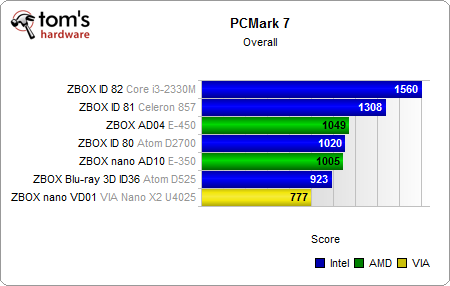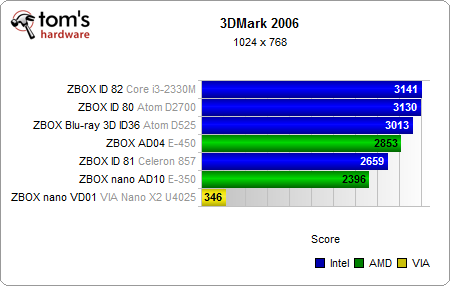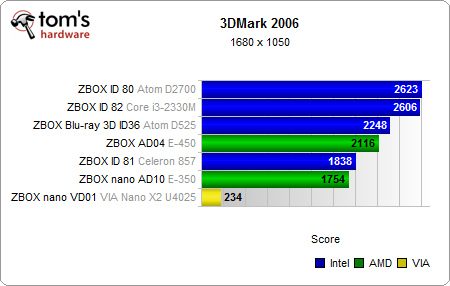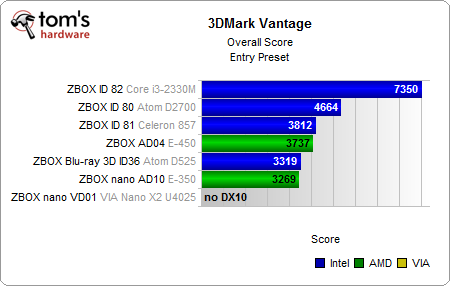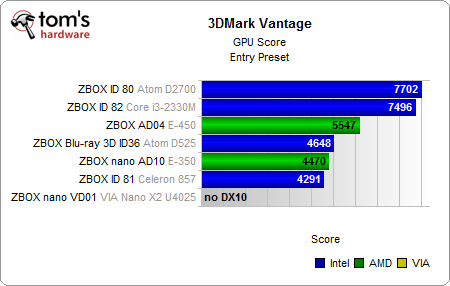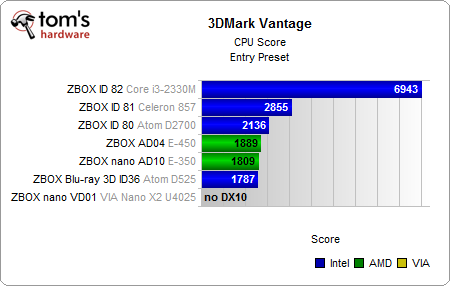Good Things In Small Packages: Seven Nettop Platforms, Tested
It'd be easy to dismiss nettops as underpowered attempts at miniaturization, but they’re good enough for surfing the Web, writing emails, and watching some video. Today, we're comparing seven different platforms based on CPUs from Intel, AMD, and VIA.
Windows Experience Index, PCMark 7, And 3DMark
Windows Experience Index
Though not exactly a benchmark, and not necessarily scientific, the Windows Experience Index does serve as a first indication of what we can expect from each of these platforms and their components.
| Header Cell - Column 0 | Zbox ID82 Plus(Core i3-2330M) | Zbox ID81 Plus(Celeron 857) | Zbox ID80 Plus (Atom D2700) | Zbox Blu-ray 3D ID36(Atom D525) | Zbox AD04 Plus(E-450) | Zbox nano AD10 Plus(E-350) | Zbox nano VD01 Plus(Nano X2 U4025) |
|---|---|---|---|---|---|---|---|
| Processor | 6.5 | 4.1 | 3.8 | 3.5 | 3.9 | 3.8 | 3.1 |
| Memory | 5.5 | 5.5 | 5.2 | 4.9 | 5.1 | 5.5 | 5.5 |
| Graphics | 4.6 | 4.4 | 5.1 | 4.8 | 4.2 | 3.9 | 4.1 |
| Gaming Graphics | 6.1 | 5.5 | 5.8 | 5.6 | 5.5 | 5.6 | 3.1 |
| Hard disk | 5.9 | 5.9 | 5.9 | 5.9 | 5.9 | 5.9 | 5.6 |
Windows correctly identifies Intel’s Core i3-2330M as the most powerful processor of the bunch, followed by its pared-back Celeron sibling. AMD’s E-450 leads the real nettop platforms, carving out a lead over the E-350 and Intel’s most modern Atom CPU. The older Atom D525 places second-to-last, with VIA’s Nano X2 bringing up the rear.
PCMark 7
Again, the Sandy Bridge-based CPUs can take a clear lead in the overall score of this semi-synthetic benchmark. To be fair, though, they were also designed for a completely different environment, borne out by their respective TDPs as well. The rest of the field remains largely unchanged, with AMD’s E-450 once more leading the nettop-oriented CPUs. E-350 and Atom D2700 come next, trading blows, with Atom D525 and Nano X2 following behind.
Looking at the individual results, the ranking shifts based on how big a role threading or graphics performance plays. Remarkably, VIA’s Nano X2 is able to beat Intel’s Atom D525 in the Lightweight and Productivity tests, despite being a much older design, running at a lower clock speed, and lacking the Intel part's Hyper-Threading functionality.
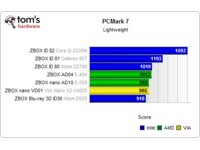
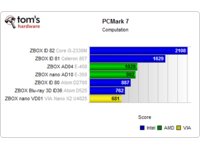
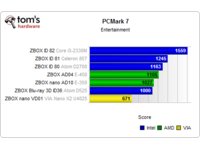
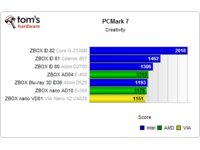
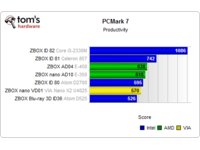
3DMark 2006
Get Tom's Hardware's best news and in-depth reviews, straight to your inbox.
While the Atom D2700 in the Zbox ID80 isn't very powerful, Zotac pairs it with a GeForce GT 520M, giving it quite a bit of graphics muscle. Interestingly, the Core i3’s HD Graphics 3000 achieves parity with the discrete GPU in both tested resolutions. AMD’s integrated GPUs don’t fare as well in this synthetic DirectX 9-based benchmark, and we see the E-450 trailing the Celeron 857, while the E-350 appears outmatched by Nvidia's Ion 2 chipset. On the other hand, Intel has a reputation for unpolished drivers, so while the graphics performance may look good on paper, the end result in games may be very different. Meanwhile, VIA’s Chrome9 engine is the only one to suffer a triple-digit score.
3DMark Vantage
The more modern 3DMark Vantage paints a different picture. At first, it seems that the Core i3-2330M outclasses its competition, with the GeForce GT 520M-supported Atom D2700 taking second place ahead of the Celeron 857 and the first of the Fusion systems. Looking at the individual scores reveals how Futuremark’s suite comes to this conclusion, though.
The GPU score yields a more expected result, with the GeForce GT 520M taking the lead, just ahead of the Zbox ID82’s HD Graphics 3000. Third place goes to the Radeon HD 6320 in AMD’s E-450. The remaining three systems place much closer together. Three? Aren’t we forgetting someone? Nope, lacking DirectX 10 support, VIA’s Chrome9 graphics has to sit this one out.
The two Sandy Bridge-based parts dominate the CPU score, although the Hyper-Threaded Atom D2700 isn’t all too far behind the dual-core Celeron 857. Next up are AMD’s E-family APUs, and this time it’s the Atom D525 that comes in last.
Current page: Windows Experience Index, PCMark 7, And 3DMark
Prev Page Three Nettop Form Factors, Taken Apart Next Page Cinebench, File Compression, And PDF Creation-
falchard I think this review is bias. Its missing the AMD small form factor benchmark. Any game.Reply -
A Bad Day JOSHSKORNIn all honesty, when it can run Crysis...I'll be impressed. Until then...alrighty.Reply
Well, if you run it in:
-320p resolution
-Directx 8
-All eyecandy off
You'll get around 5-10 FPS. -
bavman These things suck. Why would you dish out the $300-400 theyre asking for them? I recently built a file server that was basically a dumbed down tower with an g620 cpu, 4 gigs of ram for under $200 (excluding all the hdds). Throw in a $50 graphics card and it would dominate any of these nettops.Reply -
friskiest bavmanThese things suck. Why would you dish out the $300-400 theyre asking for them? I recently built a file server that was basically a dumbed down tower with an g620 cpu, 4 gigs of ram for under $200 (excluding all the hdds). Throw in a $50 graphics card and it would dominate any of these nettops.Reply
You pay for the size, power and niche factor in here,.. these are Nettops,.. you're not supposed to play AA or AAA games in here,. just browse the net,. watch movies and listen to music- as implied
-
Nintendo Maniac 64 What I really want to see is a nettop using AMD's 17w A6-4455M. Being a Trinity APU, it actually WOULD have enough grunt to run Crysis, and without it looking like crap to boot!Reply -
molo9000 Shame these still aren't good at H.264 decoding. They would make great HTPCs.Reply
The hardware decoding of the VIA chipset would be a killer feature, if there actually was some software that supported it. Seems like XBMC doesn't support it either. -
daglesj I rolled out a load of Ion 330 Asrock boxes a couple of years ago for business use. Customers still love their little black boxes. These were the early 1.6Ghz dual core Atoms.Reply
For work use (basically 95% of what 95% of the worlds computers users actually do in the REAL world) they work great.
There is more to life than endless benchmarking and Crysis.
